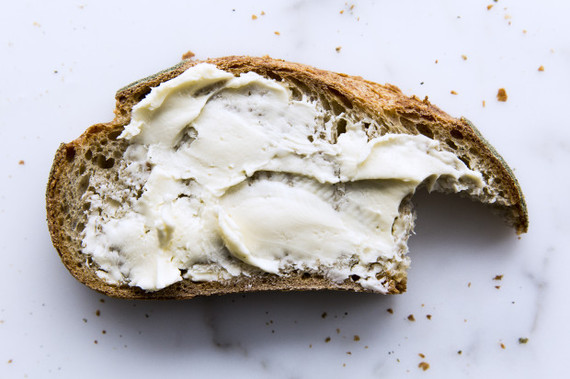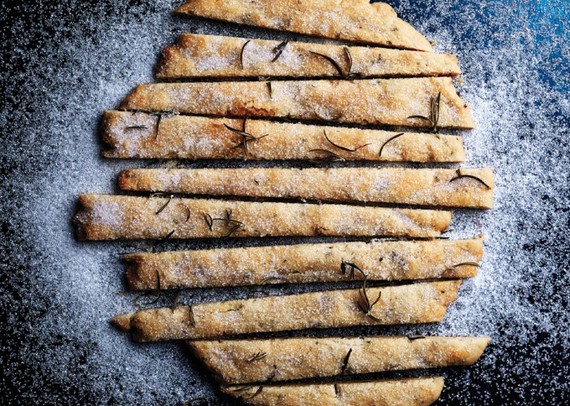
Credit: Alex Lau
It's a trope, but it's also true: Butter makes everything better. French pastries would just be sad crackers without it. Leave it out and silky pan sauces become nothing but meat juice. While a knob of butter can add richness and depth to nearly everything it touches, it can also go horribly, horribly wrong (if you've ever tried to sear a steak in butter, you know what we're talking about: Hello smoke alarms and bitter flavor). From using salted when unsalted will do, to adding it too quickly, there are a lot of common mistakes people make when cooking with butter. Here's how to avoid them all.

Baked goods that require creaming require room-temp butter. Credit: Michael Graydon + Nikole Herriot
1. Using the Wrong Temperature Butter
Butter is solid at room temperature and liquid when heated. Baked good recipes that call for creaming butter and sugar should be made with room-temperature, completely softened butter--it's easier to incorporate the two ingredients. But melt it, and the sugar crystals can't do their job of slicing through the fat, creating air pockets that give the finished product "lift." In other words: Melted butter will result in a flat, super chewy cookie, while softened butter makes for a fluffier, softer cookie. Making pie dough? Be sure the butter is very cold. This is imperative because too-soft butter won't form the tiny pea-sized "crumbs" in the dough that eventually translate to flaky crust. As for recipes that call for melted butter and eggs, like pancakes, it's best to let it cool slightly before combining it with the other ingredients. Hot melted butter will partially cook the eggs, turning your batter into sweet scrambled eggs.
2. Making Unsanctioned Swaps
Because it has a similar consistency to butter, it can be tempting to plug in coconut oil anywhere butter is called for. Proceed at your own risk! Baking is as much a science as it is an art, and the success of any given recipe depends on the specific chemical reactions between ingredients. Stick with recipes that have tested the variables, like this chocolate pound cake that relies on both coconut oil and butter for the optimal flavor and texture. (The same rules apply for other oils, like vegetable and olive oil). When it comes to sautéeing and stove-top cooking, as in the case of, say, fried eggs, it's your preference. We like using virgin olive oil instead of butter, because, again, it doesn't burn as quickly.

Butter and steak are a perfect pair--just don't add it until the steak is almost done cooking. Credit: Peden + Munk
3. Adding It Too Soon When Searing
The reason butter is so tasty is also the reason it's not ideal for high-heat cooking: The milk solids that give it a full, rounded flavor burn more quickly than fats like canola, vegetable, or virgin olive oil. But there's a way to beat the system: Baste seared meats, seafood, and veggies in butter when they're almost done cooking. The butter will turn fragrant and nutty, while helping turn the ingredient a beautiful golden brown. Alternatively, you can give protein like steak or chicken a hard sear with ghee, which is clarified butter (meaning it contains no milk solids). And one more secret tip from the test kitchen: You can sear in butter if you pack as much of your ingredient into the pan as possible, nestling it close together. While we typically advocate against crowding, covering the pan's surface with meat--like skin-on chicken, for example--ensures that the butter won't darken and burn as quickly.
4. Not Balancing the Richness with Other Flavors
No spoiler alert needed here: Butter is rich and fatty. But like any good leading lady or man, it needs supporting actors to really make it come alive. When cooking with butter in savory applications, it should be tempered with acidic and bright ingredients, like lemon juice and zest or vinegar--not to mention a little salt (see the next mistake for more on that!).

Pastries and desserts, like kouign amann, call for unsalted butter. Photo: Christopher Testani
5. Ignoring the Whole Salted/Unsalted Thing
Does it really matter whether you use salted or unsalted butter? Yes! Salted butter isn't so aggressively seasoned it'll turn a chocolate chip cookie into a savory course, but our test kitchen still prefers to bake with unsalted. This is so they can control the amount of salt that goes into a recipe--if using salted butter, you're at the mercy of the brand of butter. (Not a terrible master to obey, but still.) In a pinch, salted butter will work for cakes, cookies, and the like, but taste it first, and adjust the amount of or eliminate the pinch of salt you'd usually add. Unsalted butter is also ideal for savory sauces, allowing you to add your own level of salinity. Remember that salt is supposed to enhance the other flavors in a sweet baked good, not be a starring player.
So why is any butter salted, if it's preferable to add your own? For one, salt acts as a preservative, keeping the butter fresher for longer. It also tastes delicious! It's ideal for simple applications, when it's the star, like melting over a hot-off-the-grill steak or spreading on toast or bread. Psst--these are some of our favorite "spreading butters."
Make your own butter and blow everyone's minds.
More from Bon Appetit:
26 Gooey, Cheesy Super Bowl Party Recipes
I Ate Like Tom and Gisele for 17 Hours and Lived to Tell the Tale
24 Recipes Everyone Should Know How to Cook
35 Easy Make-Ahead Breakfasts
12 Clever YouTube Food Hacks to Make You a Smarter, Faster Cook
The Most Popular Recipes from 2015
Also on HuffPost:
-- This feed and its contents are the property of The Huffington Post, and use is subject to our terms. It may be used for personal consumption, but may not be distributed on a website.
No comments:
Post a Comment